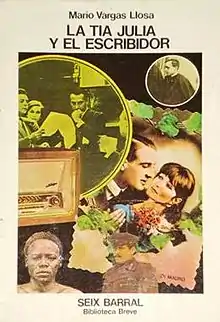Aunt Julia and the Scriptwriter
Aunt Julia and the Scriptwriter (Spanish: La tía Julia y el escribidor) is the seventh novel by Nobel Prize-winning author Mario Vargas Llosa. It was published by Editorial Seix Barral, S.A., Spain, in 1977.

Plot
Set in Peru during the 1950s, it is the story of an 18-year-old student who falls for a 32-year-old divorcee. The novel is based on the author's real life experience.
Mario, an aspiring writer, works at a radio station, Panamericana, writing news bulletins alongside the disaster-obsessed Pascual. Mario has an aunt (married to a biological uncle) whose sister, Julia, has just been divorced and has come to live with some of his family members. He frequently sees her and though at first they don't get on, they start to go to movies together and gradually become romantically involved.
Mario's bosses also run Panamericana's sister station, which broadcasts novelas (short-run soap operas). They're having problems buying the serials on bulk from Cuba, with batches of scripts being ruined and quality being poor, and hence they hire a highly eccentric Bolivian scriptwriter named Pedro Camacho to write the serials.
The novel chronicles the scriptwriter's rise and fall in tandem with the protagonist's affair and includes episodes of Pedro's serials, in prose form. These scripts tend to shed light on what the latter is like and has done, and change depending on what he's going through.
Background
It is based in part on the author's first marriage, to Julia Urquidi. Urquidi later wrote a memoir, Lo que Varguitas no dijo (What little Vargas didn't say), in which she provided her own version of their relationship.
Aunt Julia and the Scriptwriter combines a fictional account of a period in Vargas' own life with a picture of Lima in the 1950s, a satirical look at Peruvian radio soap operas, and an examination of both the practical and creative aspects of writing.
Vargas Llosa's novel was later adapted as a Hollywood feature film, Tune in Tomorrow, in which the setting was moved from Lima to New Orleans. The film was released as Aunt Julia and the Scriptwriter in many countries.[1]
Footnotes
External links
- Mario Vargas Llosa discusses Aunt Julia and the Scriptwriter on the BBC World Book Club
- A glossary of unusual words from the book